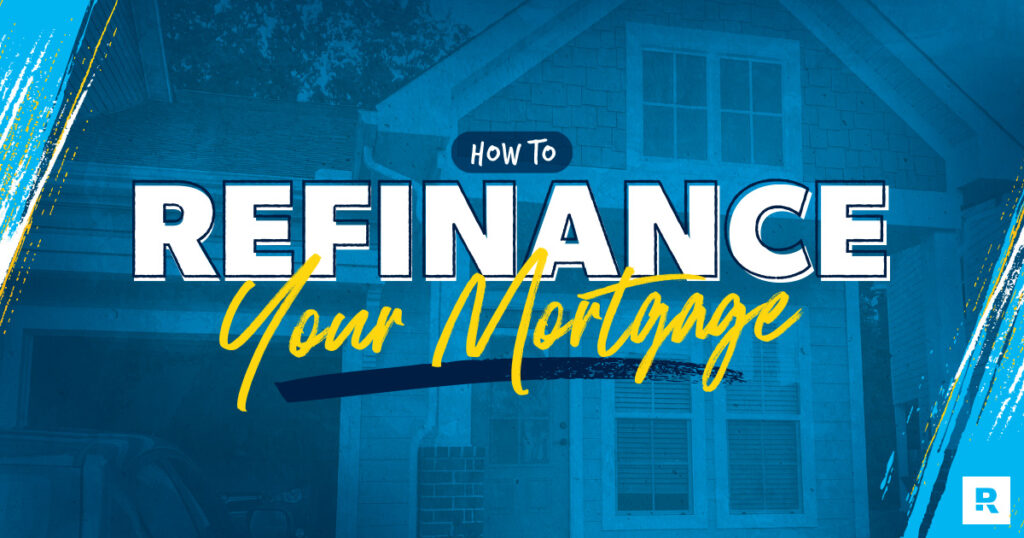We’ve got good news, folks: After a few years of mortgage interest rates constantly climbing and reaching highs we hadn’t seen in decades, rates have finally started coming back down! Yeah, that’s definitely a reason to celebrate.
It’s also a reason to talk about something that could wind up saving you a whole lot of money: mortgage refinancing. If you bought a house in the last couple of years, you may be able to refinance your mortgage and lock in a lower interest rate—potentially saving you thousands of dollars each year.
But before you pull the trigger on a refinance, you’ll want to think about a few important questions, like “What is mortgage refinancing?” and “When should you refinance your mortgage?” So, let’s go over how to refinance your mortgage.
What Is Mortgage Refinancing?
Mortgage refinancing is replacing your existing mortgage with a new mortgage, usually to get a better interest rate. It’s not a second mortgage—so you still have only one loan and one monthly payment. You’re just refinancing it. Easy enough, right?
When Should You Refinance Your Mortgage?
It’s a good idea to refinance your mortgage if it’ll give you a lower interest rate and save you more money than it costs you.
How do you figure out whether that’ll be the case? Well, it does take a little bit of math, but we promise it’s not too complicated—no need to reach for that $100 graphing calculator from high-school precalculus. There are three questions you’ll need to answer:
- How much will your interest rate go down? This is easy math! If a refinance would take you from a 7% interest rate to a 6% interest rate, the difference is . . . 1%!
- How much will you save per year by refinancing? Multiply the difference between your old and new interest rates by the total balance of your loan. Here’s what that would look like if your loan balance was $250,000 and your interest rate was dropping by 1%:
$250,000 × 0.01 = $2,500 saved per year
- What will you pay in closing costs? Since closing costs typically run about 2–6% of the total amount you’re borrowing, multiply the balance of your current mortgage by 0.04 to get a good estimate of what you’ll pay. Here’s an example, again based on a mortgage balance of $250,000:
$250,000 × 0.04 = $10,000 in closing costs
In these examples, you’d be paying $10,000 in closing costs to lower your mortgage payments by $2,500 a year. That means you’d break even and start actually saving money on your mortgage after four years.
Before moving forward with a mortgage refinance, run these numbers for yourself. There’s no hard and fast rule for “how long is too long” to break even, as long as you’re planning to stay in your house long enough to actually save some money. But if it’s going to take an eternity to get to that point, a refinance probably won’t be worth it.
Pay off your home faster by refinancing with a new low rate!
Try out our Mortgage Calculator to see how much your mortgage payment will change at different interest rates.
How to Refinance Your Mortgage
Here are the six steps you’ll need to follow if you want to refinance your mortgage.
1. Crunch the numbers.
Before you start getting in touch with lenders and get too deep into the process of refinancing your mortgage, you’ll want to make sure it’s actually the right move for your money. Like we talked about earlier, that means making sure a mortgage refinance will give you a lower interest rate and save you more money than it costs you.
So, sit down and do the math. How much will your interest rate go down? How much will you save per year by refinancing? And what will you pay in closing costs? Answering those questions will make sure you don’t wind up paying more to refinance your mortgage than you actually save.
2. Shop around for the best interest rate.
When you’re refinancing a mortgage, you don’t want to put all your eggs in one basket—or in this case, with one lender. By shopping around with multiple lenders, you could wind up with a lower interest rate than you would otherwise. Our RamseyTrusted® friends at Churchill Mortgage are a great place to start as you shop for the best rate.
3. Choose your lender.
Now it’s time to take a close look at the lenders you talked to in the last step and decide which one you’re going to use. Look for one that can give you the best bang for your buck when it comes to interest rate. And make sure to ask lenders how much they charge for closing costs, because they can vary a lot. Some lenders might discount their closing costs just to get your business.
You’ll also want to make sure you’re not signing up for any pointless fees or prepayment penalties.
4. Lock in your interest rate.
Once you’ve found your lender and a great rate, lock that puppy in! Locking in your interest rate may cost a small fee, but it’s worth it to make sure you don’t lose a great rate.
5. Go through the underwriting process.
Underwriting is a fancy word that describes the process of your mortgage lender making sure you have the means to pay your loan back. They do this by digging through pretty much every aspect of your personal finances—think bank accounts, pay stubs and your credit history.
We won’t pull any punches, here: The underwriting process can be a great big pain in the neck, and it can take a while. But hey, if a refinance is going to save you a ton of money, it’ll all be worth it in the end!
6. Close on the new mortgage.
Boom! All that’s left to do is sign all your closing documents and pay your closing costs. Closing on a new mortgage usually takes from one to two months.
Want More Expert Real Estate Advice?
Sign up for our newsletter! It’s packed with practical tips to help you tackle the housing market and buy or sell your home with confidence—delivered straight to your inbox twice a month!
Common Reasons to Refinance a Mortgage
People refinance their mortgage for all sorts of reasons! Here are four of the most common.
Lock in a lower interest rate.
This is the most common reason people refinance their mortgage, and it’s often a great idea. Again, though, you’ll want to crunch the numbers beforehand to make sure that refinancing will actually save you more money in the long run than it costs you. That won’t always be the case, even if you get a lower interest rate.
Reduce your loan term and become debt-free faster.
Some people with 30-year loans refinance to a 15-year fixed-rate mortgage so they can pay off their home faster. This can be a good idea, but only if you get a lower interest rate with the 15-year mortgage. Otherwise, you can simply add to your monthly payments on your own and pay off your house early without needing a new mortgage.
Get rid of private mortgage insurance.
If your down payment was less than 20% of your home price when you bought your home, then you were probably required to pay for private mortgage insurance (PMI). Well, here’s the deal with PMI: It’s expensive and will slow you down from paying off your principal. So, some people refinance their mortgage to get rid of PMI—especially if the value of their home has appreciated a lot since getting the mortgage.
Getting rid of PMI is a great goal, but there’s actually a much easier way to do it: Paying extra on your mortgage until the balance of your loan is less than 80% of your home’s value. Then, contact your lender and ask them to remove PMI from your payments. You may have to pay for an appraisal, but you’d have to do that anyway if you refinanced.
Switch the loan type.
Finally, some folks refinance to get out of a lousy type of mortgage they never should’ve used in the first place—like an adjustable-rate mortgage (ARM). Lots of people who use ARMs have a rude awakening a few years in when the dreamy low interest rate they got in year one turns into a nightmarishly high rate. That kind of unpredictability is a recipe for disaster.
Luckily, you can refinance your way out of your ARM and into a fixed-rate mortgage. If you currently have an ARM, our friends at Churchill Mortgage can help you decide if this is the best option for you.
The Bottom Line
At the end of the day, remember that you should only refinance if you can check these two boxes:
- Refinancing will give you a lower interest rate.
- Refinancing will save you more money in the long run than it costs you.
Yes, yes, we know we sound like a broken record—but it’s important! A refinance can be a big blessing, but it can also wind up as nothing more than a time-wasting hassle if you don’t think things through on the front end. You definitely don’t want that.


